Watching Carrot Wasps in the Garden
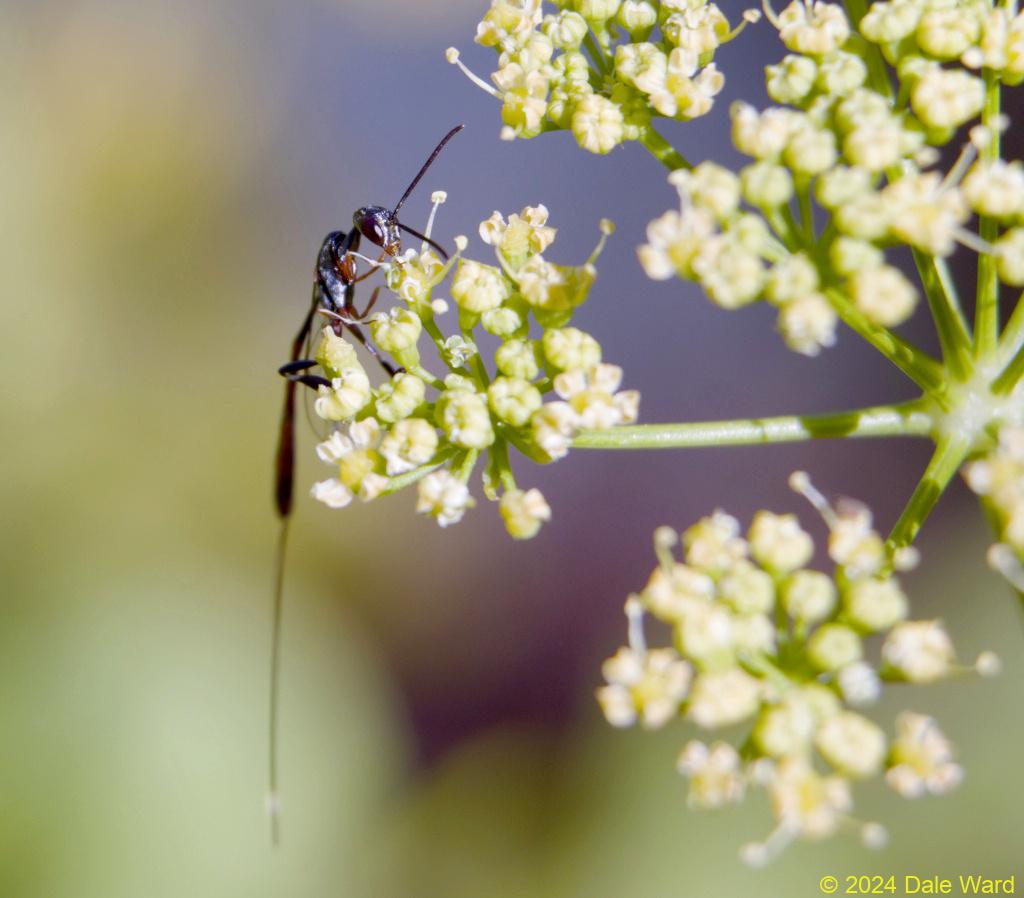 Carrot Wasp (Gasteruption sp.) on parsley flower.
Carrot Wasp (Gasteruption sp.) on parsley flower.
I live in Southwestern Colorado, at about 6200’ of elevation. This last Summer (2024), I spent a lot of time watching the insects in our garden, especially the pollinators that come into the parsley plants. The parsley attracted loads of insects, so there was usually something interesting to see.
And - perhaps most importantly - the flat shape of the parsley flower umbels made it much, much easier for me to photograph its insect visitors.
As I’d watch the flowers, every now and then I would see strange groupings of three tiny white dots floating in the air near the flowers. The dots seemed float through the air unison, but didn’t look like insects. They looked like…well…ethereal white dots, gently bouncing up and down together.
As I kept watching, I’d see the dots land on one of the parsley flowers, and then I’d see that the white dots were actually just the markings on a very strange looking wasp.
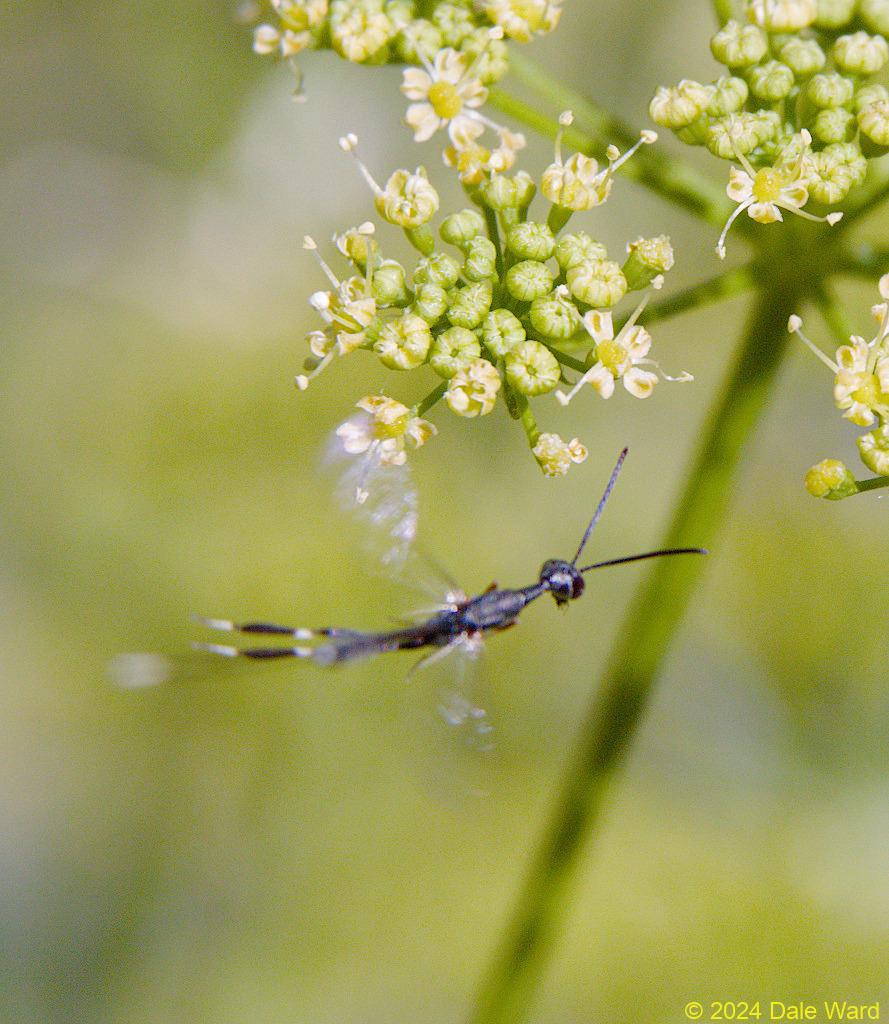 Female Carrot Wasp (Gasteruption sp.) flying near a parsley umbel. You can see the white specks on here hind legs and her long ovipositor. Those white specks were usually the first thing I’d see when watching these wasps.
Female Carrot Wasp (Gasteruption sp.) flying near a parsley umbel. You can see the white specks on here hind legs and her long ovipositor. Those white specks were usually the first thing I’d see when watching these wasps.
These wasps were a bluish-gray color. They had long bodies - perhaps an inch long. But there bodies were strangely attenuated, they were shaped almost like a pencil lead. The wasps had long, thin necks, and relatively large heads with big eyes.
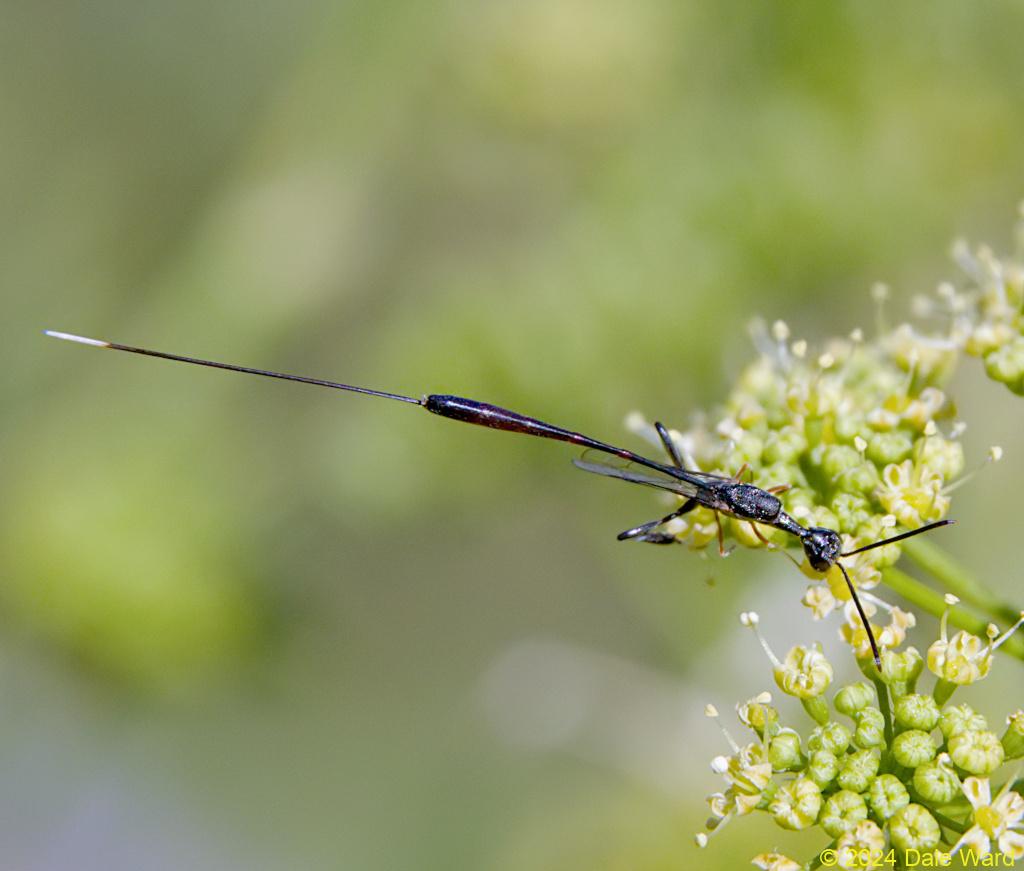 Top-down view of a female Carrot Wasp (_Gasteruption sp_) on a parsley flower. Look how attenuated her body is! The long, white-tipped ovipositor is at the left side of the photo. You can also see the wasp’s long and relatively thin neck in this photo.
Top-down view of a female Carrot Wasp (_Gasteruption sp_) on a parsley flower. Look how attenuated her body is! The long, white-tipped ovipositor is at the left side of the photo. You can also see the wasp’s long and relatively thin neck in this photo.
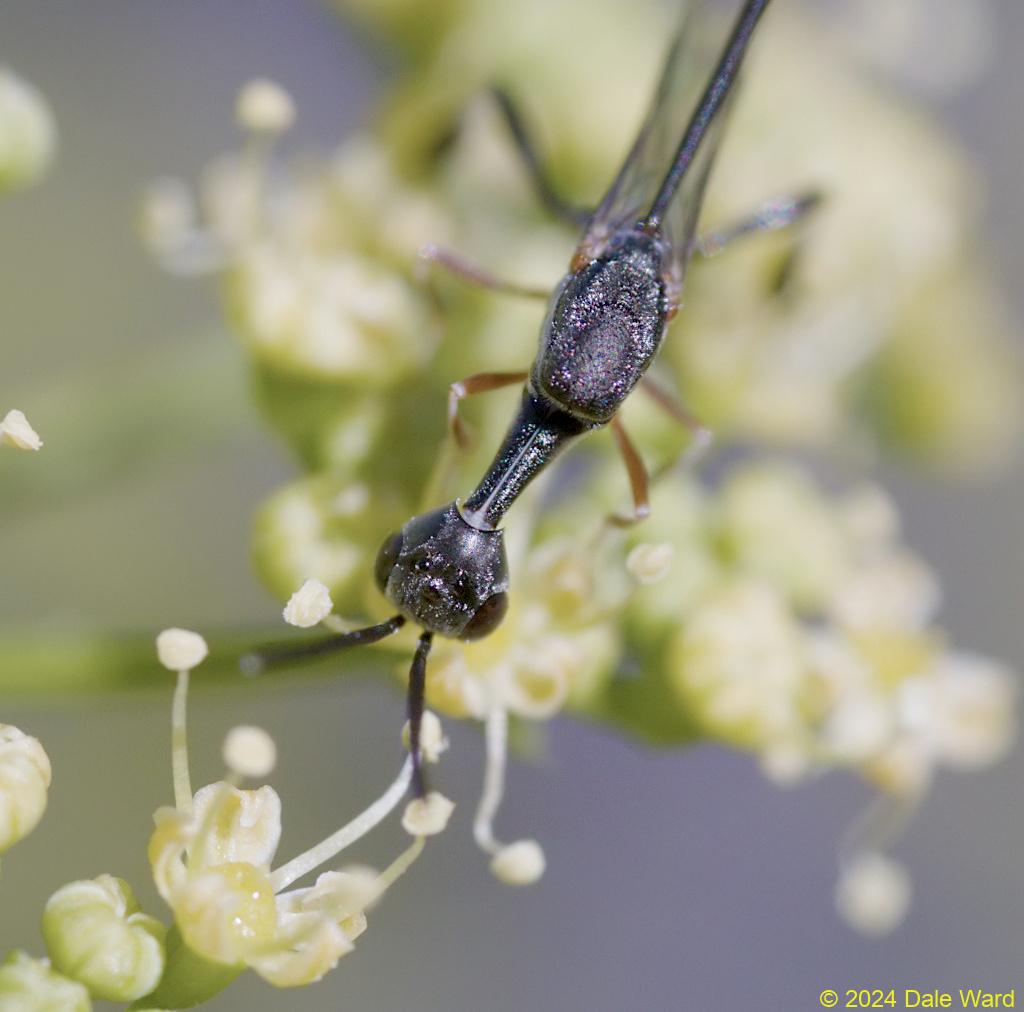 Looking down on the head and neck of a Carrot Wasp (_Gasteruption sp._). Note her long, thin neck.
Looking down on the head and neck of a Carrot Wasp (_Gasteruption sp._). Note her long, thin neck.
All of these strange wasps were females - they had those long, filamentous ovipositors trailing behind them.
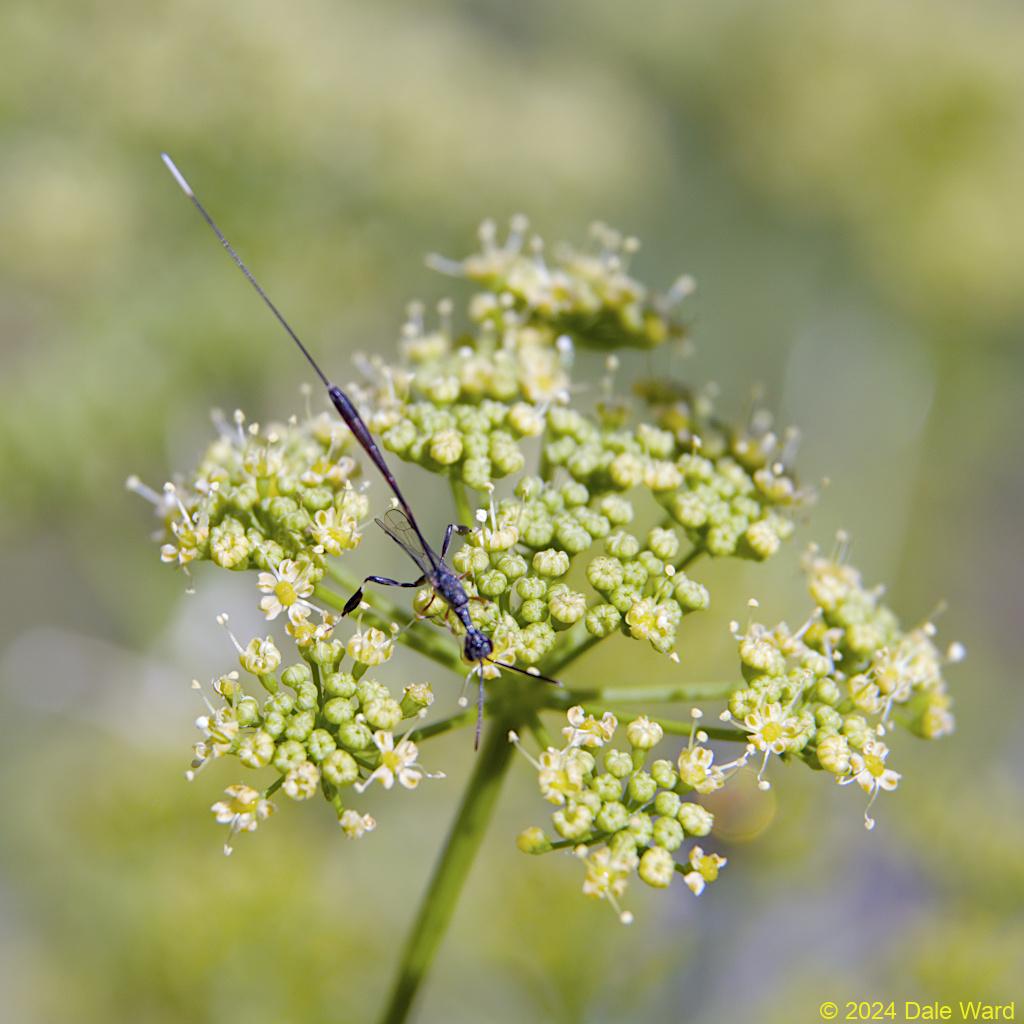 View looking down on a female Carrot Wasp (_Gasteruption sp_) feeding on a parsley flower. You can see the flattened, swollen portions of her hind legs in this shot. Some research suggests that they use those ‘saddlebags’ on their legs to detect vibrations from solitary bee larvae.
View looking down on a female Carrot Wasp (_Gasteruption sp_) feeding on a parsley flower. You can see the flattened, swollen portions of her hind legs in this shot. Some research suggests that they use those ‘saddlebags’ on their legs to detect vibrations from solitary bee larvae.
I had no idea what type of wasps these were when I first saw them. Thanks to Stephen Marshall’s book, I eventually figured out that these were members of the Gasteruptidae - the Carrot Wasp family.
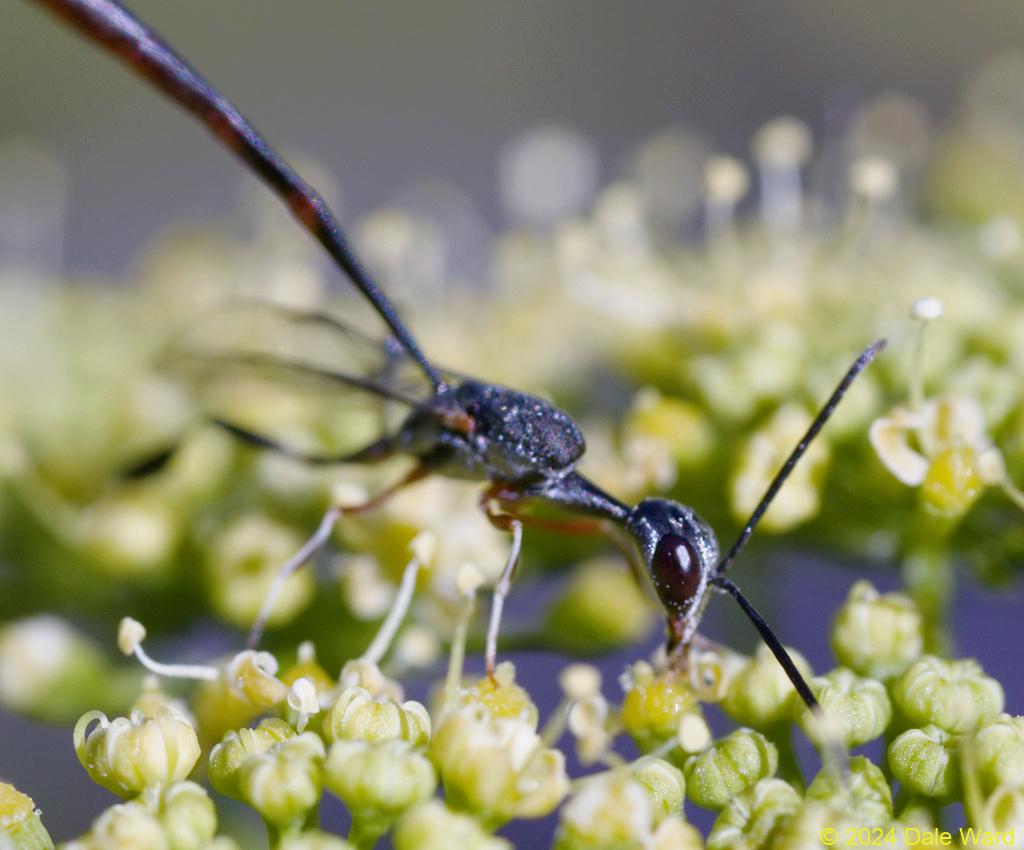 Close-up of a Carrot Wasp (_Gasteruption sp_) feeding nectar and pollen on a parsley flower. Note her long, thin neck, and beautiful big eyes.
Close-up of a Carrot Wasp (_Gasteruption sp_) feeding nectar and pollen on a parsley flower. Note her long, thin neck, and beautiful big eyes.
I was puzzled by their common name. “Carrot Wasps”? Really? It turns out that they are called “Carrot Wasps” because the adult wasps prefer to feed on nectar and pollen from plants whose flowers are easily accessible. Since carrots, parsley, and other members of the Umbelliferae produce lots of readily accessible nectar and pollen, they are favorites of Carrot Wasps. I’ve also seen them feeding on White Horehound, a member of the Mint family.
The genus of these particular Carrot Wasps is Gasteruption. I’m not sure of the species.
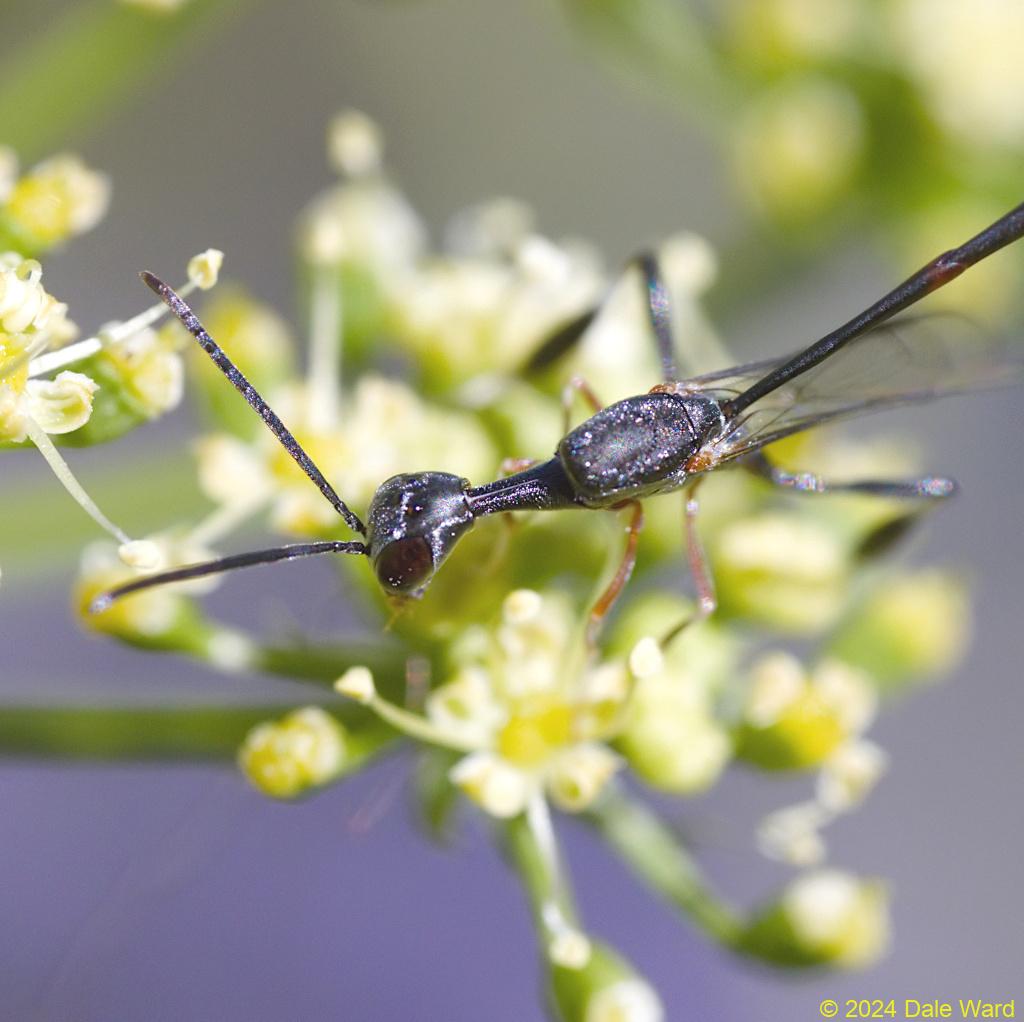 Another view of a female Carrot Wasp (Gasteruption sp.) feeding on parsley nectar. These are just such beautiful wasps.
Another view of a female Carrot Wasp (Gasteruption sp.) feeding on parsley nectar. These are just such beautiful wasps.
Carrot Wasps have an interesting life history. They seek out the nests of solitary bees, and then lay eggs in the bee’s nest. When the Carrot Wasp larvae hatch, they eat the provisions that the Solitary Bees have stored for their own offspring. And - oh, yes - they eat the Bee larva, too.
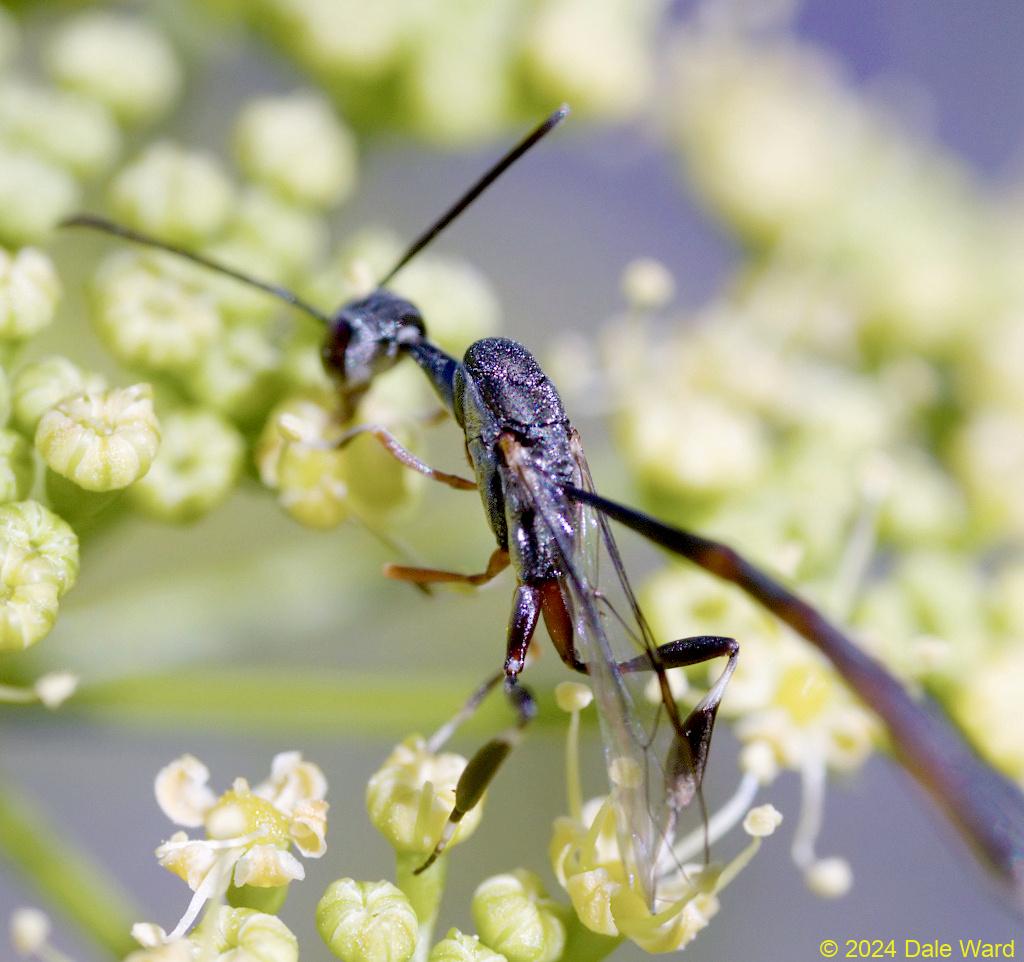 Looking at a Carrot Wasp (Gasteruption sp.) from a quartering-rear angle. You can see how her long, thin gaster inserts high up on her ‘thorax’.
Looking at a Carrot Wasp (Gasteruption sp.) from a quartering-rear angle. You can see how her long, thin gaster inserts high up on her ‘thorax’.
George Pilkington, in the UK, has some fabulous footage of a Gasteruption wasp laying eggs in a solitary bee’s nest. What I think is really cool about it - the bee’s nesting tunnel is longer than the wasp’s ovipositor. So how does the wasp reach the bee’s brood chamber?
The wasp gets entirely inside the tunnel leading to the bee’s nesting chamber, and she crawls backwards down the tunnel. She then uses her long ovipositor to feel a way through the cap that the bee placed over the bee’s brood cells,
Perhaps this behavior - the wasp’s willingness to enter into the bee’s nest - helps explain Gasteruption’s strange, elongated body shape. It makes it possible for Gasteruption to be a relatively large wasp, yet still fit into the small diameter nest tunnels of solitary bees. Watch his video here: <iframe width="560" height="315" src="https://www.youtube.com/embed/Qgfo5luy9_A" frameborder="0" allowfullscreen></iframe>
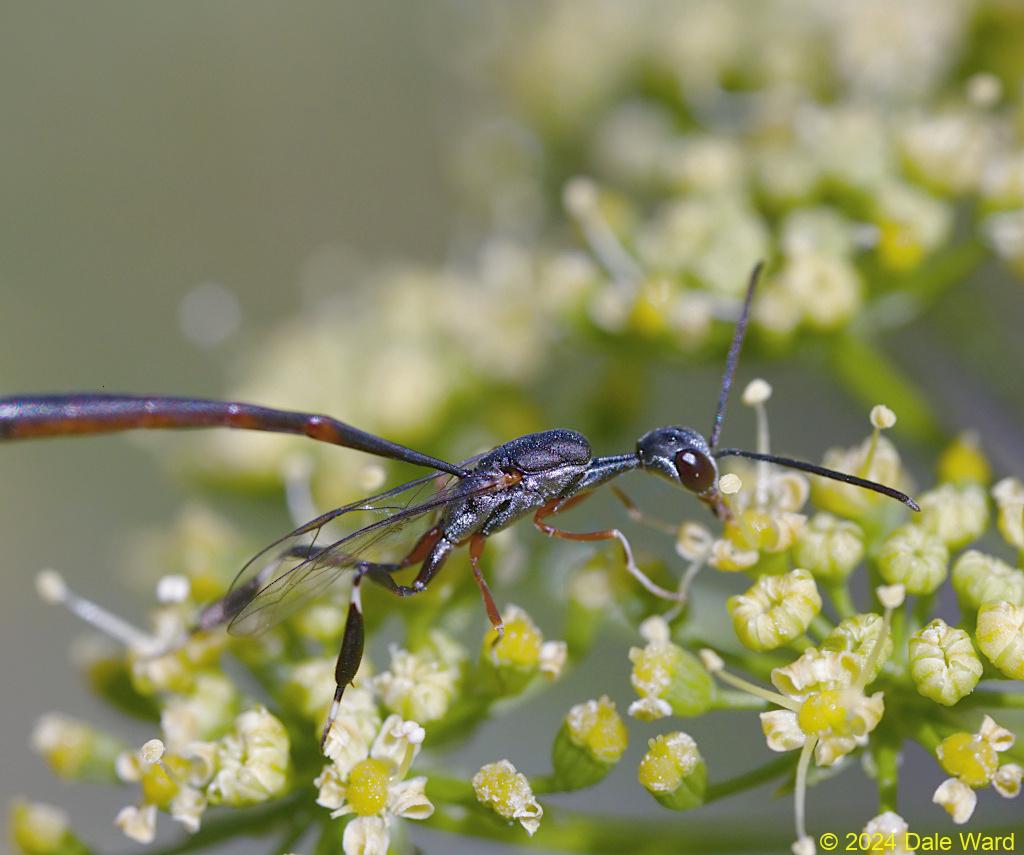 Another interesting feature of the Carrot Wasps are the swellings on its hind legs. They look a bit like saddlebags. Some people have speculated that they act as inertial stabilizers as the wasp hovers in front of tree trunks while they are looking for solitary bee nests. Recent research suggests another possible function - they may act as sensors, to detect vibrations made by the adult solitary bees as they excavate their nests, or by bee larvae as they move inside the nest chamber.
Another interesting feature of the Carrot Wasps are the swellings on its hind legs. They look a bit like saddlebags. Some people have speculated that they act as inertial stabilizers as the wasp hovers in front of tree trunks while they are looking for solitary bee nests. Recent research suggests another possible function - they may act as sensors, to detect vibrations made by the adult solitary bees as they excavate their nests, or by bee larvae as they move inside the nest chamber.
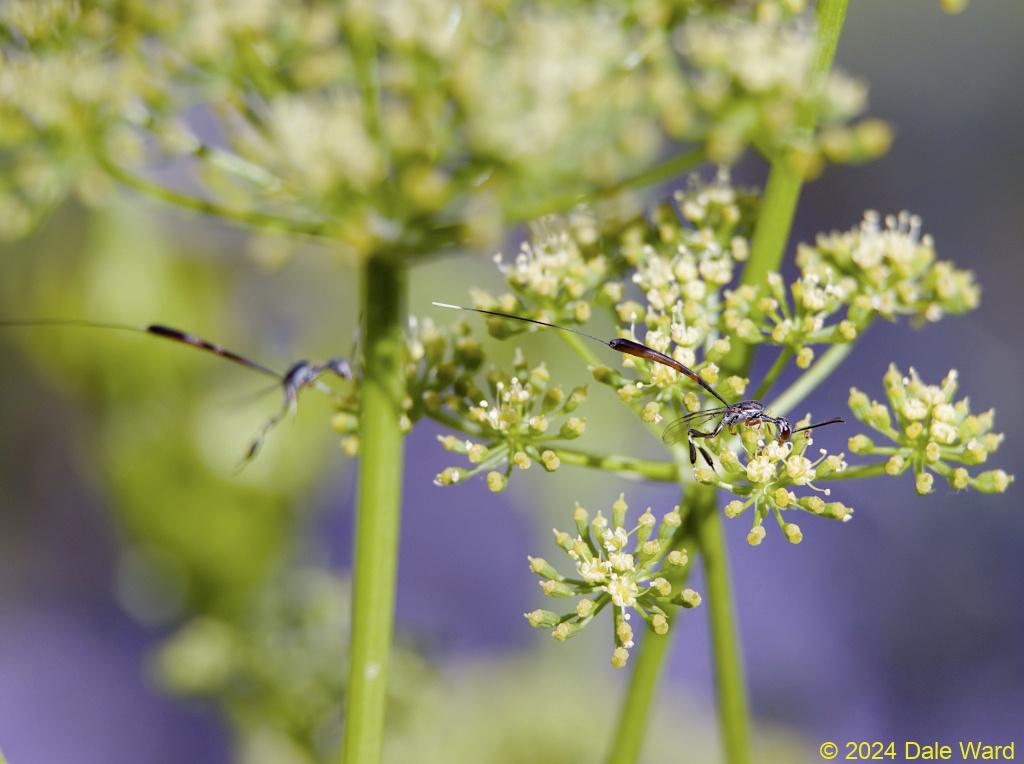 Two female Carrot Wasps on parsley flowers. The one in the left background is landing.
Two female Carrot Wasps on parsley flowers. The one in the left background is landing.
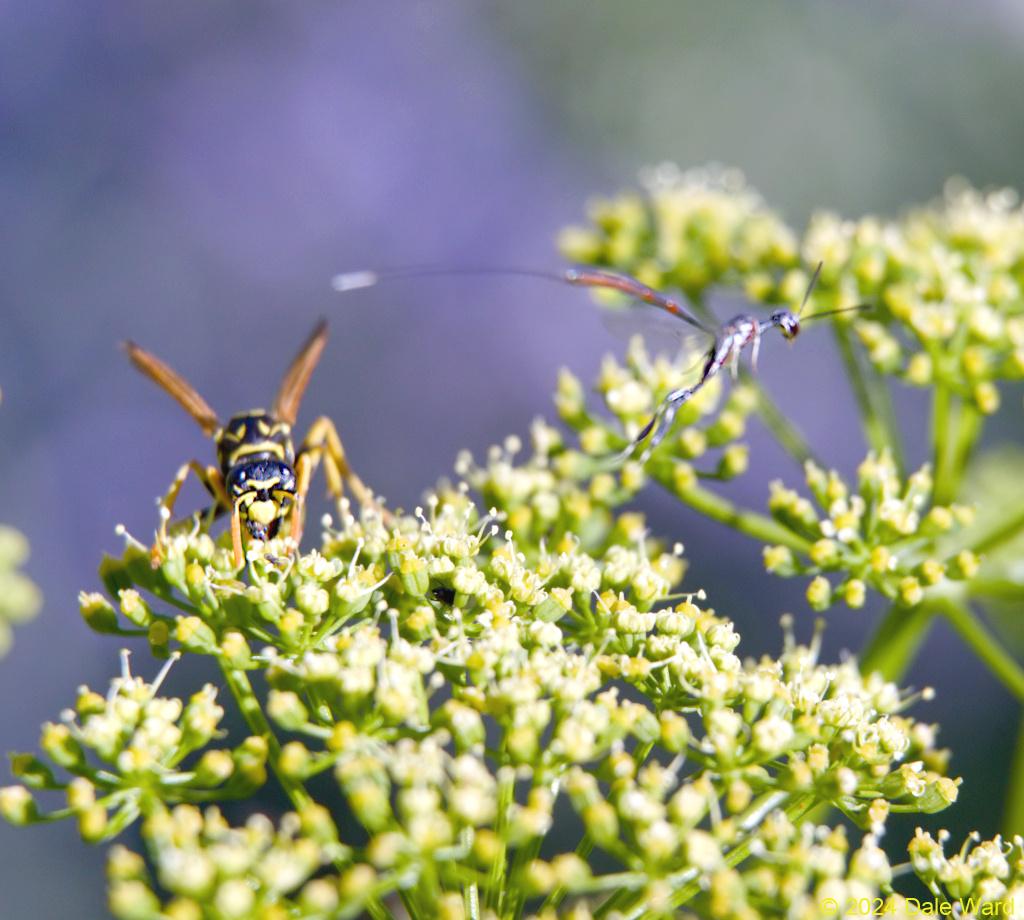 Female Carrot Wasp flying (on right), Paper Wasp (_Polistes sp._) on the left of the photo. It’s striking how lightly built, how attenuated, the Carrot Wasp is when compared with the Paper Wasp. Their body lengths are not that different, but the the Carrot Wasp is a fraction of the Paper Wasp’s size.
Female Carrot Wasp flying (on right), Paper Wasp (_Polistes sp._) on the left of the photo. It’s striking how lightly built, how attenuated, the Carrot Wasp is when compared with the Paper Wasp. Their body lengths are not that different, but the the Carrot Wasp is a fraction of the Paper Wasp’s size.
I guess the thing I find to be most striking about these wasps is not their bizarre shape, but the fact that the existence of such strangely exotic creatures is so relatively unknown. I had not heard of them prior to researching the question of “what are the strange creatures in my garden”.
I would think that these creatures would be more…I don’t know…famous?
Or maybe it just means that I need to get out more.
Sources
Watch George Pilkington’s Youtube videos! He is a naturalist/film-maker who lives in the United Kingdom. He has made solitary bee nest boxes with one clear plexiglass side. This allows him to make beautiful observations and videos of the strange goings-on inside of the nests.
Here are two that feature Gasteruption jaculator attempting to lay eggs in Hylaeus bee nests. Very, very, cool
-
“Gasteruption jaculator egg laying inside a common yellow face bee nest” Link: https://www.youtube.com/watch?v=Qgfo5luy9 A short video showing Gasteruption jaculator successfully laying eggs in an untended Hylaeus bee nest cavity.
-
“Gasteruption jaculator and the hylaeus bee battle!” Link: https://www.youtube.com/watch?v=pvDX-4WEgRo. Hylaeus Bee reacting to a Carrot Wasp that is trying to lay eggs inside its nest. He has also written an account of this interaction here, on his Nurturing Nature website (https://nurturing-nature.co.uk).
István Mikó, Sarthok Rasique Rahman, Salvatore S. Anzaldo, Thomas van de Kamp, Ben A. Parslow, Nikolai J. Tatarnic, Maxwell T. Wetherington, Julie Anderson, Rudolf J. Schilder,Jonah M. Ulmer Andrew R. Deans, and Heather M. Hine. 2019. Fat in the Leg: Function of the Expanded Hind Leg in
Gasteruptiid Wasps (Hymenoptera: Gasteruptiidae). Insect Systematics and Diversity, (2019) 3(1): 2; 1–16 doi: 10.1093/isd/ixy020.
Marshall, Stephen A. 2023. Hymenoptera: The Natural History and Diversity of Wasps, Bees and Ants. Firefly Books (April 1, 2023). 640 pages. ISBN 0228103711. ISBN-13: 978-0228103714.
Nastasi, Louis F., R. Luke Kresslein, Kendick O. Fower and Sofia R. Fernández Flores. 2023. WaspID Course Manual - Biodiversity & Classification of Wasps. Downloadable PDF, released under Creative Commons license. DOI:10.26207/ax00-rk88
Parslow, Ben A., Michael P Schwarz and Mark I. Stevens. 2020. Review of the biology and host associations of the wasp genus Gasteruption (Evanioidea: Gasteruptiidae). Zoological Journal of the Linnean Society, 2020, 189, 1105-1122.